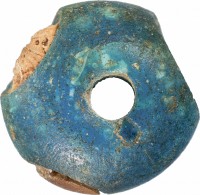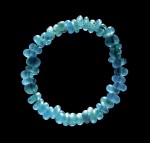 An analysis of blue glass beads found in Bronze Age burials in Denmark has revealed they were made in Egypt and Mesopotamia. It was the color of the beads that first caught the eye of Moesgaard Museum archaeologist Jeanette Varberg. She was looking through stores of ancient artifacts to see if there were any objects that would suit an upcoming exhibition when in a cardboard box she came across three beads: one large turquoise colored bead, two smaller dark blue ones. Museum records noted that the beads had been found in a burial mound urn by a farmer named Christoffersen in 1892. Then she found another box with two more blue beads, these found in a Bronze Age tomb in 1962.
An analysis of blue glass beads found in Bronze Age burials in Denmark has revealed they were made in Egypt and Mesopotamia. It was the color of the beads that first caught the eye of Moesgaard Museum archaeologist Jeanette Varberg. She was looking through stores of ancient artifacts to see if there were any objects that would suit an upcoming exhibition when in a cardboard box she came across three beads: one large turquoise colored bead, two smaller dark blue ones. Museum records noted that the beads had been found in a burial mound urn by a farmer named Christoffersen in 1892. Then she found another box with two more blue beads, these found in a Bronze Age tomb in 1962.
The blueness of them was puzzling. The Bronze Age Danish did not have the technology to make blue glass. This was a tribal, agricultural society of small settlements with no written language. When she asked her colleagues about the beads, they suggested they may have originated in Switzerland or the Mediterranean, but it was pure conjecture. The published literature (such that there was; there was no dedicated study of the blue beads), claimed that the beads were made of clay that had been colored blue using oxidized copper. Varberg knew that didn’t apply to her beads because they were translucent.
 To solve the mystery, she contacted Bernard Gratuze, director of the Institut de Recherche sur les Archéomatériaux (IRAMAT) in Orléans, France, and an expert in glass. His first inclination was that the beads had been inaccurately dated, that they were simply younger than anyone thought. That could be the case for artifacts ploughed up by farmers without any archaeological context, but there were beads with firmer histories, like the ones discovered in Voerladegård, East Jutland, by the neck of a woman buried 2,200 years ago. Varberg took a small sample from one of the broken Voerladegård beads and sent it to Gratuze for analysis. The test found that the glass originated in Mesopotamia.
To solve the mystery, she contacted Bernard Gratuze, director of the Institut de Recherche sur les Archéomatériaux (IRAMAT) in Orléans, France, and an expert in glass. His first inclination was that the beads had been inaccurately dated, that they were simply younger than anyone thought. That could be the case for artifacts ploughed up by farmers without any archaeological context, but there were beads with firmer histories, like the ones discovered in Voerladegård, East Jutland, by the neck of a woman buried 2,200 years ago. Varberg took a small sample from one of the broken Voerladegård beads and sent it to Gratuze for analysis. The test found that the glass originated in Mesopotamia.
In cooperation with curator Flemming Kaul from the National Museum — National Museum was in possession of numerous blue glass beads which up to this point had been thought to be Italian — Varberg and Gratuze set about testing a significant sample of blue beads found at Bronze Age sites in Denmark. A review found a total of 293 blue glass beads found over 51 digs in Denmark and Schleswig-Holstein. The study analyzed 23 of those beads and found that two of them came from Egypt, the rest from Mesopotamia. (The first blue bead to catch Varberg’s eye turned out to be a fake. It was made in Venice in the 1800s. Sneaky farmer Christoffersen probably threw it in the mix to get a better price from the museum. He got 26 kroner for the lot.)
 The analytic technology is incredibly precise. A laser pointed at the bead melts a microscopic hole in the surface and creates an air bubble. Plasma-spectrometry is used to analyze the chemical makeup of the air bubble. The results are then run through a database of bead findings all over southern Europe, North Africa and the Middle East to see if there are any comparable ones. The chemical fingerprint of an artifact is so precise it can be traced to a specific ancient workshop. The Mesopotamian beads were made from melted quartz sand and ash from Tigris river grass. One of the oldest came from Nippur, an ancient Sumerian city in what is today Iraq, The two Egyptian beads were made from desert cobalt in Amarna, the same workshop where Tutankhamun’s famous death mask was made around the same time (ca 1,330 B.C.) as the burial in Denmark.
The analytic technology is incredibly precise. A laser pointed at the bead melts a microscopic hole in the surface and creates an air bubble. Plasma-spectrometry is used to analyze the chemical makeup of the air bubble. The results are then run through a database of bead findings all over southern Europe, North Africa and the Middle East to see if there are any comparable ones. The chemical fingerprint of an artifact is so precise it can be traced to a specific ancient workshop. The Mesopotamian beads were made from melted quartz sand and ash from Tigris river grass. One of the oldest came from Nippur, an ancient Sumerian city in what is today Iraq, The two Egyptian beads were made from desert cobalt in Amarna, the same workshop where Tutankhamun’s famous death mask was made around the same time (ca 1,330 B.C.) as the burial in Denmark.
 It’s the first Egyptian cobalt glass found outside of the Mediterranean, and given the dates, that little bead traveled far north in a relatively short time. That suggests active trade between Bronze Age Denmark and New Kingdom Eygpt. Most of the burials where the blue glass beads were found also included amber beads. It seems likely that the rich trade in Nordic amber, well established even in the Bronze Age, is connected to the presence of Egyptian and Mesopotamian beads in Nordic graves. Amber was making its way down south while blue glass made its way up north.
It’s the first Egyptian cobalt glass found outside of the Mediterranean, and given the dates, that little bead traveled far north in a relatively short time. That suggests active trade between Bronze Age Denmark and New Kingdom Eygpt. Most of the burials where the blue glass beads were found also included amber beads. It seems likely that the rich trade in Nordic amber, well established even in the Bronze Age, is connected to the presence of Egyptian and Mesopotamian beads in Nordic graves. Amber was making its way down south while blue glass made its way up north.
It seems almost obvious when you think about it, but the blue glass beads have been long neglected as a subject of study and got caught up in some issues of archaeological nationalism. Varberg found that Sophus Müller, director of the National Museum, had proposed in 1882 that the blue beads were from Egypt, but nobody followed up. By the 1970s, some historians were keen to insist that Nordic Bronze Age culture developed independent of Mediterranean influence. One of them, Thea-Elisabeth Haevernick, concluded that the Bronze Age grave beads were colored clay, and her faulty assumption was then repeated in the literature by researchers citing her. That became the conventional wisdom even among people who had access to the beads themselves like museum curators, so the blue glass beads were labeled as local ceramic or Italian and stashed away in storage.
I suppose that now your going to go ahead and spill the beans re: Christopher and those other guys yeah leaf the red or something like that. Who would have ever guessed that the ancient societies were just that ancient. To think that the high tech world of glass bead making held the secret all these years. Certainly not a poor, old Webfoot. Don’t let a little thing like a blue bead mess up your whole perspective of the history of modern civilization. It is so much simpler to just hide those little blue beads in the bottom of your toy box for a 100 years or so. Nobody will be the wiser. OMG. I suppose the glass all throughout the desert sands of the middle east hasn’t raised an eyebrow either. What do you think that could have caused that phenomenon. A midsummer monsoon? A late fall thunder storm? Water spouts? Tropical rain? A native uprising? Sinbad? Or better yet Genghis Kahn? More likely it was the bobble heads of Easter Island. Moses? The Arc Angels thats the ticket. Glass it seems quite possible will remain as the only remnant of this ill fated society. Some 50 million years from now. Of course it will be a little cobalt blue bead/marble that spend 49.9 million years trapped inside of a rattle can of orange marking paint under the liner of a ancient land fill at the bottom of the pacific ocean not far from the current location we called Los Angeles. La Brea to be precise. :notworthy:
Sorry I neglected to mention that the rattle can mentioned above was inadvertantly left behind by a know it all county of L.A. planning department SOIL SCIENTIST. HOW FN IRONIC. DUCK U 2.
Possibly in an effort to save some wildlife habitat from inclusion in an ill fated landfill, maybe?
😆
The first bead pictured appears to have the blue part surrounding a clay center. Is that the fake one?
What a fantastic story! Thank you for bringing it to us. Wow!
It looked to me like a faceted bead with inlays, so I went online to check, and that is what it is. It is cobalt glass, more opaque than some other blue glasses. Here is a site with a photo showing the faceted sides with inlays (scroll down a bit):
http://archaeologynewsnetwork.blogspot.com/2014/12/danish-bronze-age-glass-beads-traced-to.html#.VIs3gHujt1E
I will howl in the deep lagoon
For your green glass beads, I love them so.
Give them me. Give them.
No.
“By the 1970s, some historians were keen to insist that Nordic Bronze Age culture developed independent of Mediterranean influence.” It must have been a generational thing. Certainly in my Scottish school in the fifties it was held to be axiomatic that everything ancient came from Mesopotamia and Egypt, in particular, or more generally from the Mediterranean.
I realises that subsequent evidence shows that view to be overdone, but at least there was no foolish nationalist sentiment to it: quite the contrary.
Yes, provide them with glass beads and firewater, in order to let trade do the rest. But even before that, there was certainly some sort of agricultural exchange, such as harvesting methods etc.
Without trade, however, the diffusion of metallurgy -let alone the ‘bronze age’- does not really make sense, and in particular the Danube river seems to have played a certain role in ‘westernising’ the West. The ‘Varna culture’ from the Danube outlet into the Black Sea created some of the earliest golden treasures ever with artifacts dating back to around 4750 BC.
Apart from amber in Mycenaean graves, the ‘bronze agers’ seem to have been dealing with -well- bronze. A little later, there were Greek colonies in ‘Urnfield’ France, even the use of greek letters and Mediterranean splendor. So even when going in circles here: Probably a constant is that histories and their interpretations come in fads.
Hi I like your example I found in a sample of blue beads